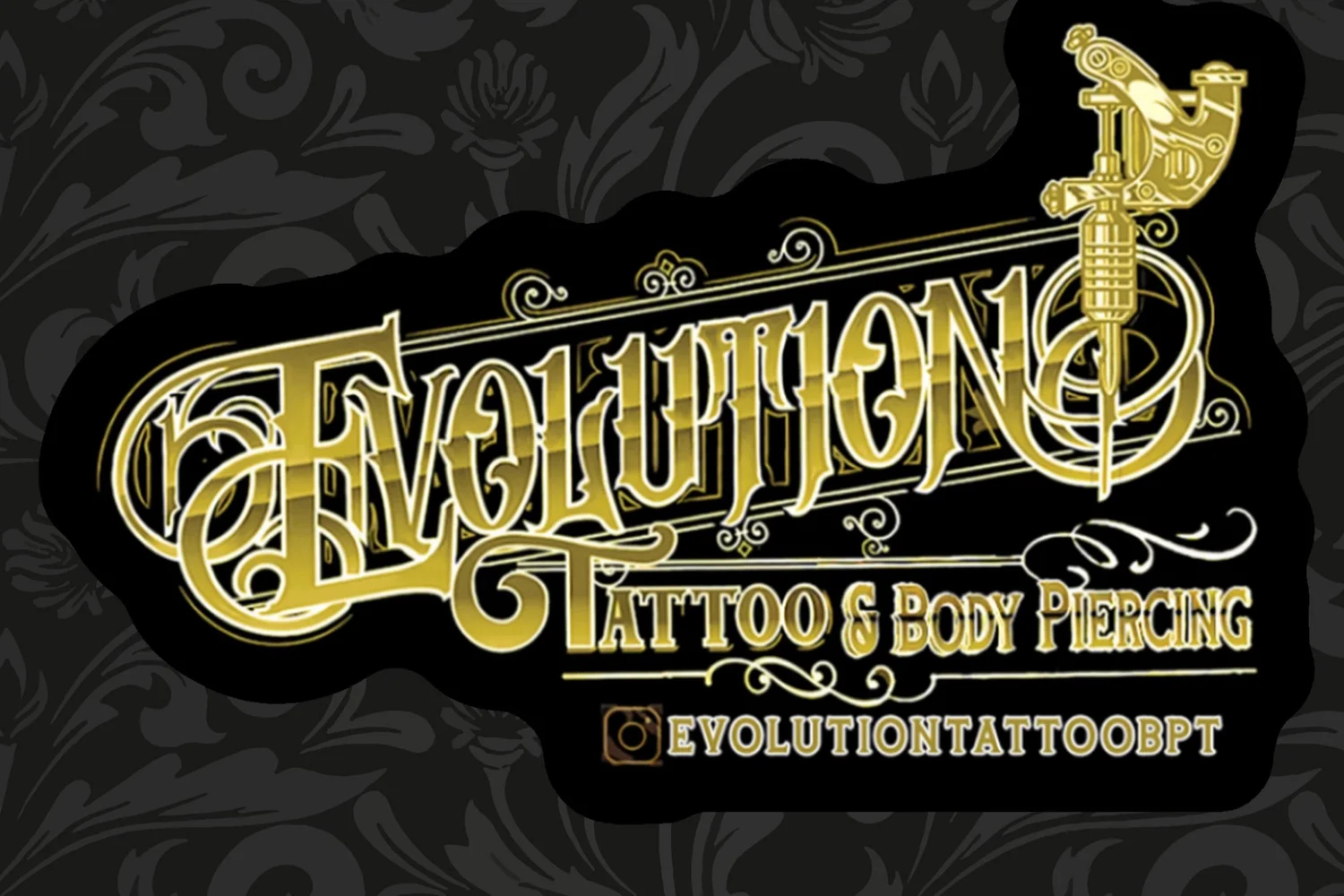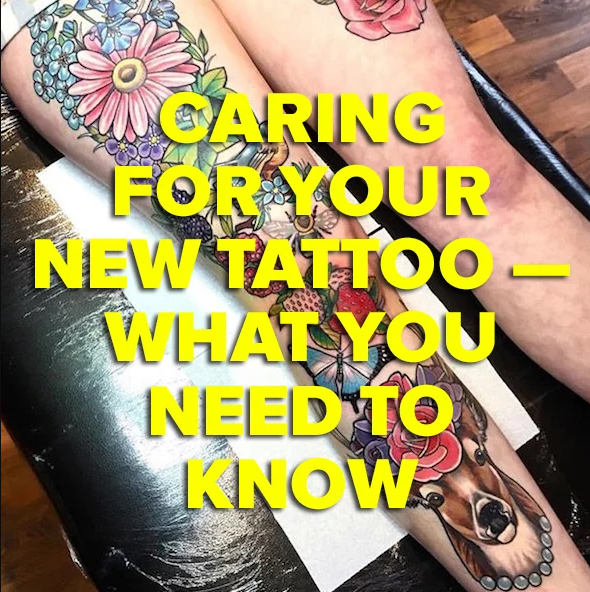Tattoo Aftercare
Suggested Aftercare For Tattoos
1. Remove bandage in a CLEAN bathroom after 2-3 hours. Bandage may be left on overnight if it feels comfortable and secure. If the bandage is removed on the first night, the tattoo may stick to or stain bed sheets. Maintain clean bedding throughout the healing process (about 2 weeks).
2. After removing bandage, wash the tattoo immediately with warm water and soap. We recommend plain Dial soap out of a pump bottle. No soap with fragrance moisture beads or scrubs.
PROCESS FOR WASHING A FRESH TATTOO:
Carefully remove bandage and tape
Make a lather in your hand with soap and warm water
Gently clean tattoo using a circular motion, until all ointment, blood, and lymphatic fluid are removed
Rinse the tattoo and wash once again, gently, until the skin is clean
a hair dryer on the ‘cool’ setting may be used; a clean paper towel may also be used to dab the tattoo dry
3. Only use CLEAN HANDS to wash your tattoo. NO washcloths, bath towels, bath sponges or loofahs on a fresh tattoo.
4. Once the tattoo is dry apply AQUAPHOR/A&D healing ointment. Apply a thin layer and rub it in, then dab excess off with a clean paper towel. Use the Aquaphor OR A&D for the first 2-3 days then switch to a regular FRAGRANCE FREE lotion such as Lubriderm, or any other fragrance free brand.
5. Fresh tattoos sometimes “weep” during the first couple of days, meaning that plasma and ink form a thin moist coating on the skin. This can be DABBED with a clean paper towel. Press the paper towel to the skin and remove. Do not wipe the tattoo or be rough with it. Do not panic when you see the colors of the tattoo on the paper towel, or on your hands as you clean it. This is simply excess ink being sloughed from the surface or the skin.
6. Once a day, in the shower, is usually enough cleaning for any new tattoo. Consult your artist if you plan to do any strenuous activity within the first ten day of having your tattoo. Lotion may be applied to the tattoo as it dries out; however if your skin is extremely sensitive, lotion may cause acne- like break outs. This can be taken care of by reducing the number of lotion applications per day.
7. Wear loose, preferably cotton clothing over the fresh tattoo. The tattoo need not be re-bandaged except in certain, rare instances. A bra strap, tight waistband, sweaty gym shoe or itchy cotton sweater can potentially create healing problems. Consult your tattoo artist for advice on what clothing to wear/avoid. If you choose to re-bandage your tattoo after washing be sure that only sterile bandages are used.
8. After a few days, the tattoo will begin to form flaky scabs that will fall off on their own. DO NOT PICK OR SCRATCH AT YOUR TATTOO. Keep it moisturized and the scabs will slough eventually. Once again, they will be the color of the tattoo. It normally takes 2-4 weeks for a tattoo to completely heal. If you have ANY questions about your healing, please contact one of our artists at 203-333-9100. Please do not consult your friends about healing issues, as everyone’s experience is unique. Our artists are more than happy to help with any concerns you might have.
Piercing Aftercare
How to Care for your Body Piercing
THIS PAGE IS FOR INFORMATIONAL PURPOSES ONLY AND CONTAINS THE BASICS, NOT THE FULL INSTRUCTIONS AVAILABLE IN THE CARE SHEET YOU RECEIVE AFTER YOU ARE PIERCED. IT IS ALWAYS ADVISABLE TO CHECK WITH YOUR PIERCER IF YOU HAVE ANY QUESTIONS, PROBLEMS OR CONCERNS ABOUT YOUR PIERCING.
Professional Piercers are highly trained in anatomy, jewelry placement, and sterilization standards. Getting your piercing done professionally at our studio gives you the best chance of having a successful experience!
Body Piercing Facts
Things to be careful of during the healing period:
Clean your hands before touching or cleaning the piercing during the healing process, and don’t let others’ hands touch the piercing at all during healing.
Avoid contact with other people’s body fluids (saliva, sweat, etc.). Even your own sweat may irritate the piercing. Be sure to rinse the area after all exercise to remove all sweat.
If you have genital piercings, always use a condom or dental dam during healing.
Always wear clean clothing and change bed sheets during healing.
If you have an ear piercing, clean your cell phone with some rubbing alcohol.
Check any threaded jewelry (such as barbells) twice a day to make sure the ends are tight, otherwise you may find yourself trying to digest your tongue bar.
A piercing is healed by your body, not by cleaning agents. Aftercare simply helps your body be in the optimum state for healing. All pierced areas should be clean and free of contaminants. An antibacterial soap is a good starting point for the cleaning of most (not all) piercings. Be sure that your regular soap does not contain any fragrances, moisturizers or deodorants. These can irritate the area. In addition to keeping the area clean, you should eat well, drink a lot of water, take your vitamins and be well rested. These things will all help your body heal. Salt water soaks can be used, but are not generally recommended for piercings other than the mouth.
TORSO PIERCING AFTERCARE
Gently wash piercing and surrounding area with antibacterial soap. Carefully remove all crusty formations from the piercing and jewelry. Rotate jewelry. Rinse off soap and rotate jewelry again, making sure all soap residue is gone. If piercing is slightly infected or irritated, soak it with antiseptic solution and work it into the piercing by rotating the jewelry, and allow it to soak for one or two minutes. Always rinse off all cleaning agents after cleaning your piercing. Warm saltwater soaks remove crusty deposits and secretions during healing. General healing times are:
Nipple, men: 2-3 months;
Nipple, women: 3-4 months;
Navel: 3-9 months.
FACIAL PIERCINGS AFTERCARE
These piercings are best cleaned with Bactine twice a day. Any crusty formation around the piercing and on the jewelry should first be softened and removed with a cotton swab dipped in warm water or warm salt water. Apply and rotate the cleaning agent through the piercing. Allow piercing to soak for one to two minutes before rinsing with warm water. Avoid heavy lotions, make-up, foundations or powders during the healing process. Cover piercing with hand or tissue when using hair spray. General healing times are: Ear lobe: 4 weeks; Eyebrow: 4-8 weeks; Nostril: 6-12 weeks; Ear cartilage: 8-12 weeks; Septum: 6-12 weeks.
MOUTH RELATED PIERCINGS AFTER-CARE
Tongue – Use a 50/50 solution of antiseptic mouthwash and water for at least 15 seconds after putting anything in your mouth other than water (this includes cigarettes). Avoid giving oral sex (receiving is fine) and wet kissing during the initial healing period. Try to avoid alcohol and spicy foods, and try to do everything slowly (i.e. Eat small bites slowly and speak slowly at first). Do not use straws for at least two weeks. General healing time: 1 week for your tongue to become “mostly functional” again, and 4-6 weeks for total healing.
Lip, Labret, Cheek – Should be cleaned on the inside as described for tongue piercings, and on the outside as described for facial piercings. Occasional warm salt water rinses can be used. General healing time: 6-8 weeks.
GENITAL PIERCINGS AFTERCARE
Genital piercings should be cleaned following the instructions for torso piercings. However, the cleaning products may irritate the urethra. For piercings that pass through the urethra, drink a lot of water and urinate often, especially after cleaning, to flush out any residues in the urethra opening. Your urine is sterile to your body. Women should take care not to let any cleaning agent enter the vagina, as yeast infections may result from the depletion of bacteria. Genital piercings should be cleaned after intercourse as well. Use of a condom is necessary during the healing period, and oral contact should be avoided. Also, certain lubricants and spermicides may irritate piercings. How long does a piercing take to heal? General healing times are:
Clit Hood, Labia Minora, Clit: 6-8 weeks;
INFORMATION ON CLEANING AGENTS FOR PIERCINGS
STRONG ANTISEPTICS
Betadine – may discolor gold or plastic jewelry. Strong antiseptics need only be used in the case of infection, and are not generally required.
MILD ANTISEPTICS
Salt Water Soak – good for loosening up crusty formations. Sea salt is best; do not use table salt.
Bactine – Bactine is an appropriate cleaning agent for facial piercings, since it contains a small amount of lidocaine. It is good for ears.
Also appropriate for infected piercings is Neutrogena Antiseptic Cleanser – a good alternative to Bactine for those people with sensitive skin or an allergy to lidocaine.
ANTIBACTERIAL SOAPS
Dilute soap 50% with bottled water, shake and apply as a liquid. Fragrance-free and color-free are best.
Provon Soap – gentle on the skin.
Antibacterial Dial – Not for sensitive skin.
Lever 2000 Antibacterial Soap – This is the best type of cleaning agent to start with. For most piercings, it is enough to keep it clean and bacteria-free, and allow the body to do its healing unassisted.
MOUTH-RELATED CLEANING AGENTS
Gly-oxide, Peroxyl – Used by oral surgeons and dentists to enhance healing, these rinses should be used only in the case of mild infection.
Mouthwash – There are many suitable brands of mouthwash, but it is important to choose an antiseptic one that does not contain alcohol. Tech 2000 is a good example. For some people, too much use of mouthwash can kill the mouth’s own bacteria (if this happens, you’ll notice bad breath and an off-color tongue).
Anbesol – Anbesol is appropriate for tongues and the insides of lips. Although it stings a bit when you apply it, it also numbs the area and is good if the piercing is particularly sore. Anbesol may also help reduce keloiding.
Zinc supplements are not generally recommended.


